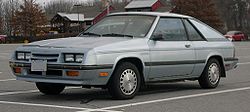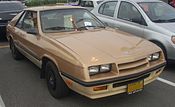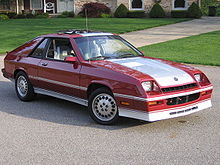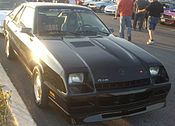- Dodge Charger (L-body)
-
- See also Dodge Charger for other models using this name and Shelby Charger, a high-performance version
Dodge Charger 
Manufacturer Chrysler Corporation Also called Plymouth Duster
Plymouth TurismoProduction 1983–1987 Assembly Belvidere, Illinois, United States Predecessor Dodge Omni 024 Successor Dodge Shadow/Plymouth Sundance Class Subcompact Body style 3-door hatchback Layout FF layout Platform L-body Engine 1.7 L Peugeot I4
2.2 L K I4
2.2 L Turbo I I4
2.2 L Turbo II I4Transmission 5-speed manual
4-speed Volkswagen manual
3-speed A413 automaticWheelbase 96.5 in (2,451 mm) Length 174.8 in (4,440 mm) Width 66.1 in (1,679 mm) Height 50.7 in (1,288 mm) Related Dodge Omni
Dodge Rampage
Plymouth Horizon
Plymouth Scamp
Shelby GLHSThe Dodge Charger (L-body) was built by Dodge, a division of Chrysler Corporation. There have been a number of vehicles bearing the Charger nameplate, but the name has generally denoted a performance model in the Dodge range. The 1983–1987 Chargers were based on the front-wheel drive Chrysler L platform.
Contents
History
For 1979, Chrysler brought out sporty versions of the L-body Dodge Omni/Plymouth Horizon called the Dodge Omni 024 and the Plymouth Horizon TC3. The cars shared a 70 hp (52 kW) 1.7 L Volkswagen I4 as the only engine under the O24/TC3 name.
In 1981, the Charger nameplate returned as a performance package on the Omni 024. Called the Charger 2.2, it cost $399 extra and came with a hood scoop, quarter-window appliques, special gearing, rear spoiler and "Charger 2.2" tape graphics and the new 84 hp (63 kW) 2.2 L I4 which was designed and built by Chrysler. 7,306 were built.
In 1982, the Dodge Charger returned for a second year as the performance option for the 024. Nothing was changed from 1981 except for a Pentastar emblem on its hood and the addition of a resonator to the exhaust, since the previous model had no muffler, utilizing the catalytic converter as the sole method of engine noise reduction.
In 1983, the Volkswagen engine went out of production, so a joint Chrysler/Peugeot 1.6 L engine was used instead. The Omni 024 was renamed the Charger. But the big news was that Carroll Shelby would create a sporty version of the car later during the year (see Dodge Shelby Charger below).
The transformation continued in 1984, with quad headlights now differentiating the Charger from its Omni origins. The Plymouth Turismo would share the same front end. In fact, apart from the badging, both cars were exactly the same.
For 1985, the Shelby and Charger names were shuffled to reflect the addition of a turbocharged engine (see Dodge Shelby Charger below). Two new colors were added for 1985 — Black and Garnet Red with silver stripes. Plymouth also got a version of the old Shelby Charger, reviving the Duster name as the Plymouth Turismo/Duster. However, Plymouth would never get a turbocharged version of the Shelby Charger. Two turbocharged Turismos, using the Shelby front end, were paraded around Chrysler headquarters and used a famous Plymouth badge of 'Cuda, but Carroll Shelby put a stop to any serious thought of putting them into production. He felt that having a Plymouth version of his Shelby Charger would take away from the mystique. The previous high-compression 107 hp (80 kW) Shelby Charger engine was now an option on regular Dodge Chargers. For 1986, the mandated center high-mounted stop light was added, and the 96 hp (72 kW) 2.2 L engine made its way down to the base models.
1987 was the last year for the Omni/Horizon-derived Charger and Turismo. 2,011 Chargers with the hotter 174 hp (130 kW) Turbo II engine were now badged the Shelby Charger Turbo (not "Dodge"). For 1987, they were replaced by the Dodge Shadow/Plymouth Sundance, and the Belvidere plant was retooled to build the Dodge Dynasty, which succeeded the preceding 600 at the time. These should not be confused with the real 1987 Shelby Charger, though — Carroll Shelby bought 1,000 of the last Chargers and packed them with the Omni GLH's engine and suspension to be sold under this name. The Plymouth Duster name continued on the new Plymouth Sundance line mid-year in 1992.
Dodge Shelby Charger
Main article: Shelby ChargerFor 1983, Carroll Shelby modified the Dodge Charger, to be sold at Dodge dealers as the Dodge Shelby Charger. Rather than focusing on speed, Shelby modified the suspension and styling. The engine compression was raised for 107 hp (80 kW), and the manual transmission had revised ratios. Shorter springs and special wheels and tires complemented stronger brakes and quicker steering. Outside, a new nose and racing stripes accented the performance image. The body kits, among other parts, were often shipped to dealerships along with the car to be put on after delivery. The reasoning behind this varied, but was said to speed delivery and compensate for ground clearance issues that the cars faced on many car carriers. Production was 8,251 for that first year.
For 1984, the Shelby Charger could be ordered with an optional automatic transmission. 7,552 total Shelby Chargers were sold in this year. The high-output engine (now up to 110 hp (82 kW)) was also available in baseline Chargers and Turismos, though it was rare. These vehicles came dressed in the "Charger 2.2" and "Turismo 2.2" schemes, which included Shelby Charger side GFX, an additional, skinnier, front ground effect (different than the Shelby Charger's due to the quad-headlight fascia), "2.2" decals, and an optional hood scoop.
The MPFI/Turbocharged Turbo I engine, commonly known as a 'T1' was added for Dodge's 1985 Shelby Charger. This engine produced 146 hp (109 kW) and was much changed from its first appearance in the Daytona Turbo the previous year. A Garrett AiResearch T3 turbocharger and Chrysler/Bosch multiple-point fuel injection enabled the 2.2 L engine to produce the additional horsepower.[1] 7,709 Shelby Chargers were made that year (1985), and 7,669 were produced in 1986. 1987 was the final year, with just 1,011 produced, plus 1,000 more Shelby Chargers that were sent to Shelby's Whittier Plant in CA, at which time were modified as the 1987 Shelby GLHS. Dodge Shelby Chargers were available in four different color combinations: Black w/silver skunk stripe (1985–87), Santa Fe Blue w/silver skunk stripe (1983–86), Silver w/Santa Fe Blue skunk stripe (1983–86), and Garnett Red w/silver skunk stripe (1984–87).
Charger GLHS
Further information: Shelby GLHS#1987Carroll Shelby purchased 1,000 of the last Dodge Shelby Chargers and converted them into GLHSs in his facility at Whittier, California. Every single one was built and optioned the same way and all had special badging that marked them as Shelby, not as a Dodge. This was a continuation of the Omni GLHS from the previous year. Shelby used the Turbo I engine updated with the intercooler and plumbing of the Turbo II engine, but without the stronger forged crank, full-floating pin pistons and other durability enhancements of that engine, good for 175 hp (130 kW) and 175 lb·ft (237 N·m) of torque. The suspension was upgraded with Koni adjustable struts/shocks and uprated Z tires. The only color was black and they were all equipped the same. A special sticker on the speedometer upped the readout to 135 mph (217 km/h). A special numbered Shelby Automotive badge went in place of the normal Charger badge. The cost of this special Charger was US$12,995.
See also
References
- Article needs references.
External links
Dodge Current
productionCarsTrucks (Ram)Discontinued Cars024 · 330 · 400 · 600 · 880 · Aries · Aspen · Avenger · Brisa · Challenger · Charger (B-body) · Charger (L-body) · Charger Daytona · Colt · Conquest · Coronet · Custom 880 · Dart · Daytona · Demon · Diplomat · Dynasty · Intrepid · La Femme · Lancer · Matador · Mirada · Monaco · Neon · Omni · Phoenix · Polara · SE · Shadow · Sierra · Spirit · SRT-4 · St. Regis · Stealth · Stratus · Super BeeTrucks50 Series · 100 Series · 500 Series · A100 · B Series · C Series · D Series · Power Wagon · Rampage · Ram 50 · VC series · VF series · WC seriesCorporate Category:Dodge vehicles · Chrysler LLC« previous — Dodge road car timeline, United States market, 1980s–present Type 1980s 1990s 2000s 2010s 0 1 2 3 4 5 6 7 8 9 0 1 2 3 4 5 6 7 8 9 0 1 2 3 4 5 6 7 8 9 0 1 2 Subcompact Omni Colt Colt Colt Colt Omni 024 Charger Compact Colt 400 Shadow Neon Neon Caliber Aspen Aries Mid-size Lancer Mirada 600 Spirit Avenger Diplomat Dynasty Stratus Stratus Full-size St. Regis Monaco Intrepid Intrepid Magnum Charger Charger Sport compact Daytona Avenger SRT-4 Sports Challenger Conquest Stealth Challenger Viper Viper Viper Viper Historic CarsAcclaim • Arrow • Barracuda • Belvedere • Breeze • Cambridge • Caravelle • Champ • Colt • Concord • Conquest • Cranbrook • Cricket (North America, Canada) • Deluxe • Duster • Fury • Gran Fury • GTX • Horizon • Laser • Neon • Plaza • Prowler • Reliant • Road Runner • Sapporo • Satellite • Savoy • Special Deluxe • Sundance • Superbird • TC3 • Turismo • Valiant • VIP • VolaréAdventurer • Voyager/Grand Voyager • TraildusterConcept CarsCategories:- Dodge vehicles
- Front wheel drive vehicles
- Subcompact cars
- Hatchbacks
- 1980s automobiles
Wikimedia Foundation. 2010.



